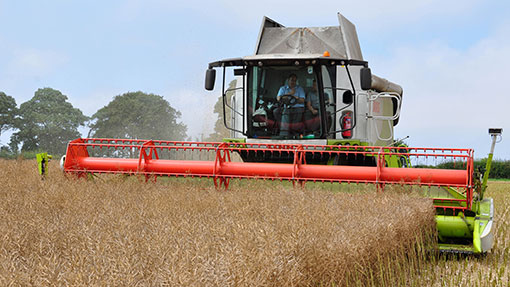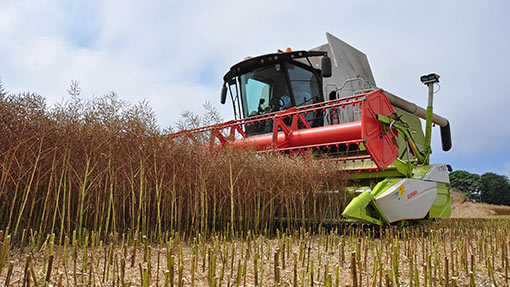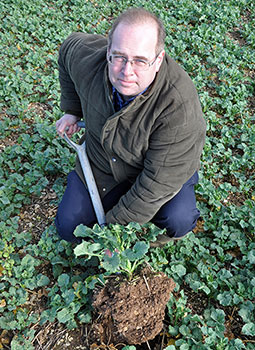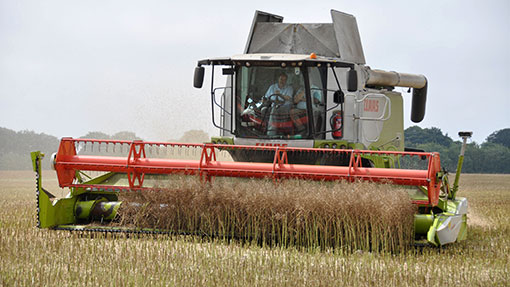World record set by Lincs oilseed rape grower

A Lincolnshire grower has set a new world record for oilseed rape yields.
Combining in the third week of July, Tim Lamyman of Worlaby Farms near Louth averaged 6.14t/ha from an 8.9ha block of Charger oilseed rape.
Mr Lamyman – who holds the current UK wheat yield record with a 14.31t/ha crop of Kielder – says that the Charger cut well, but combining was a steady job because of the thickness of the stems and the size of the pods.
“You could see the potential of the crop from the combine cab, in the way that the weight of the pods meant they had filled back in over the tramlines 14 days after we had sprayed the crop off.”
See also: World record barley yield attempt
Each trailer load was sampled with trailers running over a nearby public weighbridge. Over the four hours the crop was combined, moistures dropped from 13.7% to 12% and the yield was calculated on an agreed 9% standard for the seven trailer loads. Oil content averaged 45%.

Cutting the Charger oilseed rape
Three independent adjudicators oversaw the record-breaking attempt. They were lead by machinery consultant Bill Basford – who has been called upon to assess a number of previous UK yield records – and he was supported by equipment specialist Chris Rothery and expert adjudicator Richard Harvey.
The day prior to the record attempt yields off the headlands were coming in at 5.5t/ha and 9.6% moisture. Some parts of the field did 7.6t/ha and, even while others areas were some way behind, they still came in at a respectable 5.4t/ha.
However, Mr Lamyman believes his 6.14t/ha gross output could have been even higher as sea mists had delayed the record attempt and the pods had become brittle, making higher header losses an possible issue. With a relative humidity of 78% on the day, this too may well have had an effect.
Mr Lamyman chose Charger – which is joint top variety for yield on the UK Recommended List – having seen it at Cereals 2013. It was drilled on 14th August at 2.5kg/ha and followed two winter cereals, the previous crop being winter barley.

“It looked well in all three plots at Cereals and clearly had the potential to produce a good, secure canopy on stiff, short straw,” he says.
“Here on the farm it was fast to emerge with good vigour and rooting in what was a perfect autumn and looked like a record breaking crop from word go.”
Mr Lamyman’s nutritional approach probably sets him apart from most growers. His view is that nitrogen applications should be done on a little-and-often basis, ensuring that the crop is getting what it needs, when it needs it.
Agronomist Simon Shaw from Farmacy has been providing advice to tailor inputs according to crop requirements.
“We believe we have gone as far as we can with fungicides and in some respects we are going backwards as disease resistance increases. Instead we are trying to take the stress out of the plant through perfecting its nutrition,” explains Mr Shaw.

The final cut
“The key is to ensure that there is no part of the field that is in stress and by delivering nitrogen that is more bio-available, every plant has better potential to maximise yield.”
The Charger crop had NHK and NHCa Delta – liquid nitrogen and potassium (15%N : 8%K) products – seven times throughout the season, starting at the two-leaf stage.
“Throughout the year we’ve seen no signs of any stress and the crop was greener for longer than other parts of the farm.”
At flowering the liquid fertiliser regime was bolstered by a calcium formulation – Calflux – plus boron and molybdenum product Rainbow to deliver all the essentials to the plant for the high-stress, high-demand pod-set period.
The boron and molybdenum within Rainbow Wave also meant that the Charger crop was a darker green right through to maturity.
Tim Lamyman could well find his name against another record in the next three to four weeks. He has high hopes for a field of KWS Kielder winter wheat which he is hoping to cut at the end of August.

